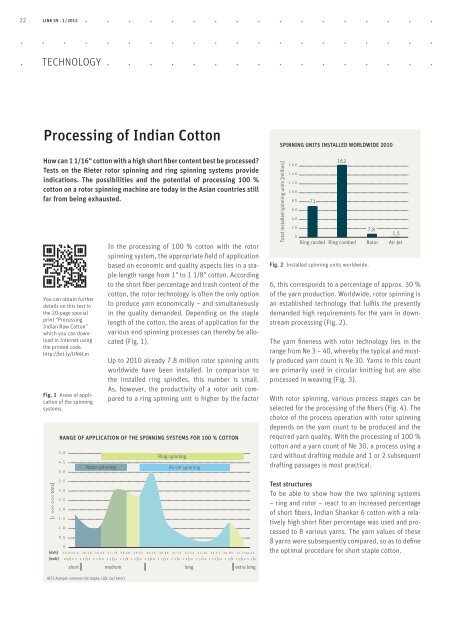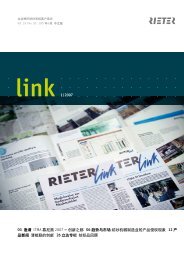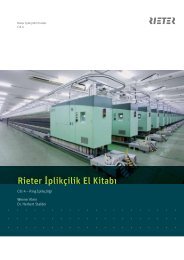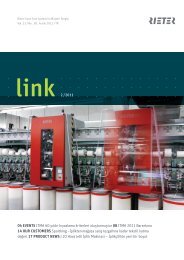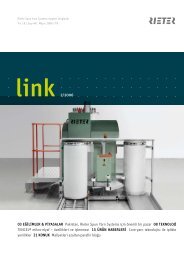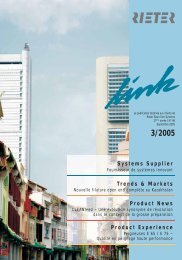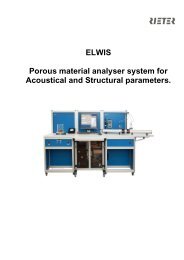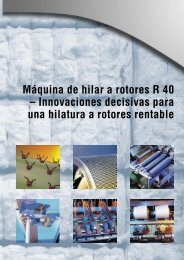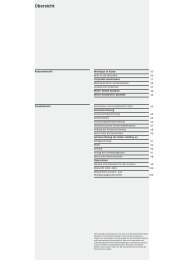link no. 59 customer magazine spun yarn systems - Rieter
link no. 59 customer magazine spun yarn systems - Rieter
link no. 59 customer magazine spun yarn systems - Rieter
You also want an ePaper? Increase the reach of your titles
YUMPU automatically turns print PDFs into web optimized ePapers that Google loves.
22 LINK <strong>59</strong> . 1 /2012<br />
TECHNOLOGY<br />
Processing of Indian Cotton<br />
How can 1 1/16" cotton with a high short fiber content best be processed?<br />
Tests on the <strong>Rieter</strong> rotor spinning and ring spinning <strong>systems</strong> provide<br />
indications. The possibilities and the potential of processing 100 %<br />
cotton on a rotor spinning machine are today in the Asian countries still<br />
far from being exhausted.<br />
You can obtain further<br />
details on this test in<br />
the 20-page special<br />
print “Processing<br />
Indian Raw Cotton”<br />
which you can download<br />
in Internet using<br />
the printed code.<br />
http://bit.ly/ItN4Lm<br />
Fig. 1 Areas of application<br />
of the spinning<br />
<strong>systems</strong>.<br />
[1 0 0 0 0 0 0 tons]<br />
(mm)<br />
(inch)<br />
RANGE OF APPLICATION OF THE SPINNING SYSTEMS FOR 100 % COTTON<br />
5 . 0<br />
4 . 5<br />
4 . 0<br />
3 . 5<br />
3 . 0<br />
2 . 5<br />
2 . 0<br />
1 . 5<br />
1 . 0<br />
0 . 5<br />
0<br />
2 3 . 0-2 5 . 4 2 6 . 1 9 2 6 . 9 9 2 7 . 7 8 2 8 . 5 8 2 9 . 3 7 3 0 . 1 6 3 0 . 9 6 3 1 . 7 5 3 2 . 5 4 3 3 . 3 4 3 4 . 1 3 3 4 . 9 3 3 5 . 7 -4 4 . 4 1<br />
2 9 /3 2 -1 1 1 /3 2 1 1 /1 6 1 3 /3 2 1 1 /8 1 5 /3 2 1 3 /1 6 1 7 /3 2 1 1 /4 1 9 /3 2 1 5 /1 6 1 1 1 /3 2 1 3 /8 1 3 /3 2 -1 3 /4<br />
short<br />
AFIS Autojet; commercial staple; UQL (w) (mm)<br />
In the processing of 100 % cotton with the rotor<br />
spinning system, the appropriate field of application<br />
based on eco<strong>no</strong>mic and quality aspects lies in a staple<br />
length range from 1" to 1 1/8" cotton. According<br />
to the short fiber percentage and trash content of the<br />
cotton, the rotor tech<strong>no</strong>logy is often the only option<br />
to produce <strong>yarn</strong> eco<strong>no</strong>mically – and simultaneously<br />
in the quality demanded. Depending on the staple<br />
length of the cotton, the areas of application for the<br />
various end spinning processes can thereby be allocated<br />
(Fig. 1).<br />
Up to 2010 already 7.8 million rotor spinning units<br />
worldwide have been installed. In comparison to<br />
the installed ring spindles, this number is small.<br />
As, however, the productivity of a rotor unit compared<br />
to a ring spinning unit is higher by the factor<br />
Ring spinning<br />
Rotor spinning Air-jet spinning<br />
medium long extra long<br />
SPINNING UNITS INSTALLED WORLDWIDE 2010<br />
Total installed spinning units [million]<br />
1 6 0<br />
1 4 0<br />
1 2 0<br />
1 0 0<br />
8 0<br />
6 0<br />
4 0<br />
2 0<br />
0<br />
71<br />
162<br />
Fig. 2 Installed spinning units worldwide.<br />
7,8<br />
1,5<br />
Ring carded Ring combed Rotor Air-Jet<br />
6, this corresponds to a percentage of approx. 30 %<br />
of the <strong>yarn</strong> production. Worldwide, rotor spinning is<br />
an established tech<strong>no</strong>logy that fulfils the presently<br />
demanded high requirements for the <strong>yarn</strong> in downstream<br />
processing (Fig. 2).<br />
The <strong>yarn</strong> fineness with rotor tech<strong>no</strong>logy lies in the<br />
range from Ne 3 – 40, whereby the typical and mostly<br />
produced <strong>yarn</strong> count is Ne 30. Yarns in this count<br />
are primarily used in circular knitting but are also<br />
processed in weaving (Fig. 3).<br />
With rotor spinning, various process stages can be<br />
selected for the processing of the fibers (Fig. 4). The<br />
choice of the process operation with rotor spinning<br />
depends on the <strong>yarn</strong> count to be produced and the<br />
required <strong>yarn</strong> quality. With the processing of 100 %<br />
cotton and a <strong>yarn</strong> count of Ne 30, a process using a<br />
card without drafting module and 1 or 2 subsequent<br />
drafting passages is most practical.<br />
Test structures<br />
To be able to show how the two spinning <strong>systems</strong><br />
– ring and rotor – react to an increased percentage<br />
of short fibers, Indian Shankar 6 cotton with a relatively<br />
high short fiber percentage was used and processed<br />
to 8 various <strong>yarn</strong>s. The <strong>yarn</strong> values of these<br />
8 <strong>yarn</strong>s were subsequently compared, so as to define<br />
the optimal procedure for short staple cotton.


